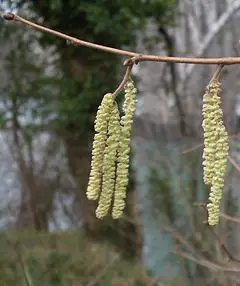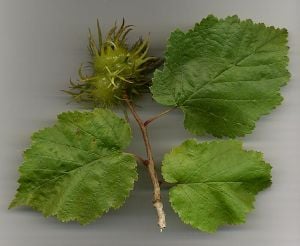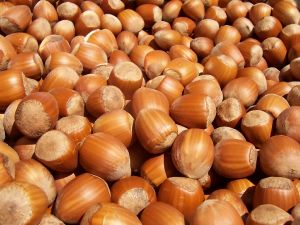Difference between revisions of "Hazel" - New World Encyclopedia
Rick Swarts (talk | contribs) (New page: {{otheruses4|the type of tree}} {{Taxobox | name = Hazel | image = Hazel Catkins.jpg | image_width = 240px | image_caption = Flowering Common Hazel in early spring | regnum = Plantae ...) |
Rick Swarts (talk | contribs) |
||
| Line 18: | Line 18: | ||
The '''hazels''' ('''''Corylus''''') are a genus of [[deciduous]] [[tree]]s and large [[shrub]]s native to the temperate northern hemisphere. The genus is usually placed in the [[birch]] family [[Betulaceae]],<ref name=grin>Germplasm Resources Information Network: [http://www.ars-grin.gov/cgi-bin/npgs/html/genus.pl?2962 ''Corylus'']</ref><ref name=chen>Chen, Z.-D. et al. (1999). Phylogeny and evolution of the Betulaceae as inferred from DNA sequences, morphology, and paleobotany. ''Amer. J. Bot''. 86: 1168–1181. Available [http://www.amjbot.org/cgi/content/full/86/8/1168?ck=nck#F5 online.]</ref><ref name=rushforth>Rushforth, K. (1999). ''Trees of Britain and Europe''. Collins ISBN 0-00-220013-9.</ref><ref name=rhs>Huxley, A., ed. (1992). ''New RHS Dictionary of Gardening''. Macmillan ISBN 0-333-47494-5.</ref> though some botanists split the hazels (with the [[hornbeam]]s and allied genera) into a separate family Corylaceae.<ref name=bean1>Bean, W. J. (1976). ''Trees and Shrubs Hardy in the British Isles'' 8th ed., vol. 1. John Murray ISBN 0-7195-1790-7.</ref><ref name=>Erdogan, V. & Mehlenbacher, S. A. (2002). Phylogenetic analysis of hazelnut species (Corylus, Corylacae) based on morphology and phenology. ''Sist. Bot. Dergisi'' 9: 83–100.</ref> | The '''hazels''' ('''''Corylus''''') are a genus of [[deciduous]] [[tree]]s and large [[shrub]]s native to the temperate northern hemisphere. The genus is usually placed in the [[birch]] family [[Betulaceae]],<ref name=grin>Germplasm Resources Information Network: [http://www.ars-grin.gov/cgi-bin/npgs/html/genus.pl?2962 ''Corylus'']</ref><ref name=chen>Chen, Z.-D. et al. (1999). Phylogeny and evolution of the Betulaceae as inferred from DNA sequences, morphology, and paleobotany. ''Amer. J. Bot''. 86: 1168–1181. Available [http://www.amjbot.org/cgi/content/full/86/8/1168?ck=nck#F5 online.]</ref><ref name=rushforth>Rushforth, K. (1999). ''Trees of Britain and Europe''. Collins ISBN 0-00-220013-9.</ref><ref name=rhs>Huxley, A., ed. (1992). ''New RHS Dictionary of Gardening''. Macmillan ISBN 0-333-47494-5.</ref> though some botanists split the hazels (with the [[hornbeam]]s and allied genera) into a separate family Corylaceae.<ref name=bean1>Bean, W. J. (1976). ''Trees and Shrubs Hardy in the British Isles'' 8th ed., vol. 1. John Murray ISBN 0-7195-1790-7.</ref><ref name=>Erdogan, V. & Mehlenbacher, S. A. (2002). Phylogenetic analysis of hazelnut species (Corylus, Corylacae) based on morphology and phenology. ''Sist. Bot. Dergisi'' 9: 83–100.</ref> | ||
| − | [[Image:TurkHazel.jpg| | + | |
| + | ==Description== | ||
| + | |||
| + | [[Image:TurkHazel.jpg|right|thumb|Leaves and nuts of Turkish Hazel: note the spiny involucres (husks) surrounding the nuts]] | ||
They have simple, rounded [[leaf|leaves]] with double-serrate margins. The [[flower]]s are produced very early in spring before the leaves, and are [[plant sexuality|monoecious]], with single-sex [[catkin]]s, the male pale yellow and 5–12 cm long, the female very small and largely concealed in the buds, with only the bright red 1–3 mm long [[Carpel|style]]s visible. The [[seed]]s are [[Nut (fruit)|nuts]] 1–2.5 cm long and 1–2 cm diameter, surrounded by an involucre (husk) which partly to fully encloses the nut.<ref name=rushforth/> | They have simple, rounded [[leaf|leaves]] with double-serrate margins. The [[flower]]s are produced very early in spring before the leaves, and are [[plant sexuality|monoecious]], with single-sex [[catkin]]s, the male pale yellow and 5–12 cm long, the female very small and largely concealed in the buds, with only the bright red 1–3 mm long [[Carpel|style]]s visible. The [[seed]]s are [[Nut (fruit)|nuts]] 1–2.5 cm long and 1–2 cm diameter, surrounded by an involucre (husk) which partly to fully encloses the nut.<ref name=rushforth/> | ||
Revision as of 18:06, 20 April 2008
- This article is about the type of tree. For other uses of the term, see Hazel (disambiguation).
| Hazel | ||||||||||||
|---|---|---|---|---|---|---|---|---|---|---|---|---|
 Flowering Common Hazel in early spring
| ||||||||||||
| Scientific classification | ||||||||||||
| ||||||||||||
|
See text |
The hazels (Corylus) are a genus of deciduous trees and large shrubs native to the temperate northern hemisphere. The genus is usually placed in the birch family Betulaceae,[1][2][3][4] though some botanists split the hazels (with the hornbeams and allied genera) into a separate family Corylaceae.[5][6]
Description
They have simple, rounded leaves with double-serrate margins. The flowers are produced very early in spring before the leaves, and are monoecious, with single-sex catkins, the male pale yellow and 5–12 cm long, the female very small and largely concealed in the buds, with only the bright red 1–3 mm long styles visible. The seeds are nuts 1–2.5 cm long and 1–2 cm diameter, surrounded by an involucre (husk) which partly to fully encloses the nut.[3]
The shape and structure of the involucre, and also the growth habit (whether a tree or a suckering shrub), are important in the identification of the different species of hazel.[3]
Hazels are used as food plants by the larvae of various species of Lepidoptera; see list of Lepidoptera that feed on hazels.
Species
There are 14–18 species of hazel. the circumscription of species in eastern Asia is disputed, with the Kew Checklist and the Flora of China differing in which taxa are accepted; within this region, only those taxa accepted by both sources are listed below.[7][3][8][9] The species are grouped as follows:
- Nut surrounded by a soft, leafy involucre. Multi-stemmed, suckering shrubs to 12m tall.
- Involucre short, about the same length as the nut.
- Corylus americana — American Hazel. Eastern North America.
- Corylus avellana — Common Hazel. Europe and western Asia.
- Corylus heterophylla — Asian Hazel. Asia.
- Corylus yunnanensis — Yunnan Hazel. Central and southern China.
- Involucre long, twice the length of the nut or more, forming a 'beak'.
- Corylus colchica — Colchican Filbert. Caucasus.
- Corylus cornuta — Beaked Hazel. North America.
- Corylus maxima — Filbert. Southeastern Europe and southwest Asia.
- Corylus sieboldiana — Asian Beaked Hazel. Northeastern Asia and Japan (syn. C. mandshurica).
- Involucre short, about the same length as the nut.
- Nut surrounded by a stiff, spiny involucre. Single-stemmed trees to 20–35 m tall.
- Involucre moderately spiny and also with glandular hairs.
- Corylus chinensis — Chinese Hazel. Western China.
- Corylus colurna — Turkish Hazel. Southeastern Europe and Asia Minor.
- Corylus fargesii — Farges' Hazel. Western China.
- Corylus jacquemontii — Jacquemont's Hazel. Himalaya.
- Corylus wangii — Wang's Hazel. Southwest China.
- Involucre densely spiny, resembling a chestnut burr.
- Corylus ferox — Himalayan Hazel. Himalaya, Tibet and southwest China (syn. C. tibetica).
- Involucre moderately spiny and also with glandular hairs.
Several hybrids exist, and can occur between species in different sections of the genus, e.g. Corylus × colurnoides (C. avellana × C. colurna).
Uses
The nuts of all hazels are edible. The Common Hazel is the species most extensively grown for its nuts, followed in importance by the Filbert. Nuts are also harvested from the other species, but apart from the Filbert, none is of significant commercial importance.[4]
A number of cultivars of the Common Hazel and Filbert are grown as ornamental plants in gardens, including forms with contorted stems (C. avellana 'Contorta', popularly known as "Harry Lauder's walking stick" from its gnarled appearance); with weeping branches (C. avellana 'Pendula'); and with purple leaves (C. maxima 'Purpurea').
ReferencesISBN links support NWE through referral fees
- ↑ Germplasm Resources Information Network: Corylus
- ↑ Chen, Z.-D. et al. (1999). Phylogeny and evolution of the Betulaceae as inferred from DNA sequences, morphology, and paleobotany. Amer. J. Bot. 86: 1168–1181. Available online.
- ↑ 3.0 3.1 3.2 3.3 Rushforth, K. (1999). Trees of Britain and Europe. Collins ISBN 0-00-220013-9.
- ↑ 4.0 4.1 Huxley, A., ed. (1992). New RHS Dictionary of Gardening. Macmillan ISBN 0-333-47494-5.
- ↑ Bean, W. J. (1976). Trees and Shrubs Hardy in the British Isles 8th ed., vol. 1. John Murray ISBN 0-7195-1790-7.
- ↑ Erdogan, V. & Mehlenbacher, S. A. (2002). Phylogenetic analysis of hazelnut species (Corylus, Corylacae) based on morphology and phenology. Sist. Bot. Dergisi 9: 83–100.
- ↑ Kew Checklist: Corylus
- ↑ Flora of China: Corylus
- ↑ Flora of North America: Corylus
{{credit|Hazel|206501087}]

